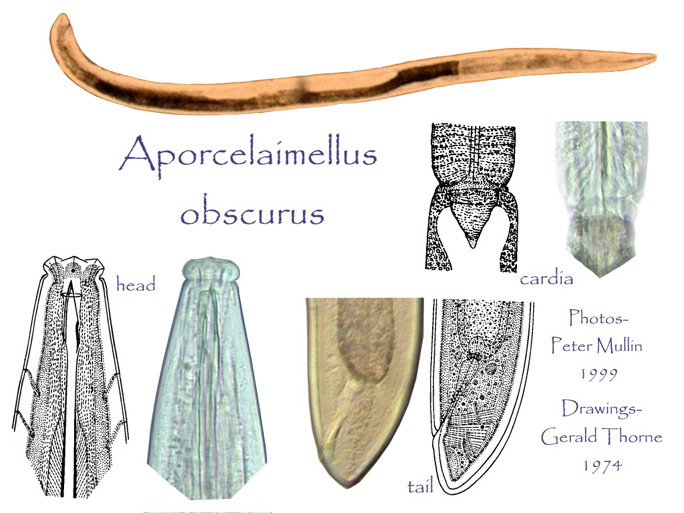

|
Photo Gallery- Nine-mile Prairie Photo Gallery- Haughton Crater |
Lip
region angular, set off by deep constriction, its width about 1/3 that
of neck base. Amphids of large specimens frequently with stiffening
element. Spear
about
as long as lip region width, its aperture occupying about 1/2 its length.
Esophagus
enlarged by very gradual expansion near its middle, the dorsal gland well
behind aperture. Cardia bluntly conoid with disc-like anterior portion,
usually slightly thicker on dorsal side. Lateral field about 1/5
body width. Vulva
transverse with sclerotized labia. Vagina extending 2/5 across body.
Ovaries reflexed about 1/2 their length. Eggs varying from 1 to 3
body widths long but usually only slightly longer than body width. Tail
dorsally
arcuate to bluntly rounded terminus with conspicuous double
layer of its cuticle, often with prominent radial striae. Caudal
papillae 2, arranged in tandem. Males
very rare and apparently not functional, although testes are filled with
sperms, associated females have not been observed spermatized.
Aporcelaimellus obscurus is distinct
because of its relatively large size, angular lips, symmetrically bluntly
rounded tail with conspicuous double layer of tail cuticle.
Habitat: Probably the most common
species of DORYLAIMOIDEA in the Northern Great Plains, being present in
almost every soil sample collected in any locality. The variation
in body length and egg size sometimes becomes confusing and may tempt the
worker to establish several subspecies. However, extensive collections
show that the various morphological characters overlap until it is impossible
to separate them.
DNA Sequences Obtained
| Specimen: | Collected: |
| KonzaI FF-53 | Konza Prairie, First survey |
| KonzaI BB-35 | Konza Prairie, First survey |
| KonzaI FF-140 | Konza Prairie, First survey |
| KonzaII BC-39 | Konza Prairie, First survey |
| SD SJ3-12 | South Dakota bearberry |
| SD SJ3-02 | South Dakota bearberry |
| TX1-06 | Texas corn |
 |
 |